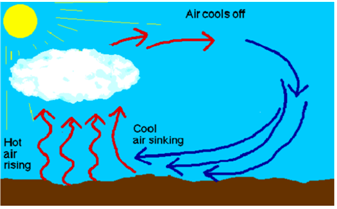CBSE
Class 10 Class 12
Air is a mixture of many gases like nitrogen, oxygen, carbon dioxide and water vapour. All living beings need oxygen to break down glucose molecules and get energy for their activities.This results in the production of carbon dioxide.

The percentage of carbon dioxide in our atmosphere is a mere fraction of a percent because carbon dioxide is ‘fixed’ in two ways: (i) Green plants convert carbon dioxide into glucose in the presence of Sunlight and (ii) many marine animals use carbonates dissolved in sea-water to make their shells.


These phenomena are the result of changes that take place in our atmosphere due to the heating of air and the formation of water vapour. Water vapour is formed due to the heating of water bodies and the activities of living organisms. The rise in temperature creates a low-pressure zone which attracts cool air from the high-pressure zone and pushes up the hot air. Thus the atmosphere can be heated from below by the radiation that is reflected back or re-radiated by the land or water bodies. On being heated, convection currents are set up in the air.

Atmosphere covers the Earth, like a blanket. We know that air is a bad conductor of heat. The atmosphere keeps the average temperature of the Earth fairly steady during the day and even during the course of the whole year. The atmosphere prevents the sudden increase in temperature during the daylight hours. And during the night, it slows down the escape of heat into outer space. The moon, which is about the same distance from the Sun that the Earth is, with no atmosphere, the temperature ranges from –190o C to 110o C.